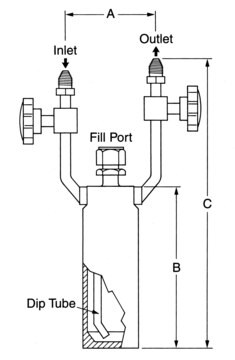687502
Titanium(IV) isopropoxide
packaged for use in deposition systems
Synonim(y):
TTIP, Tetraisopropyl orthotitanate
About This Item
Polecane produkty
Próba
99.999%
Postać
liquid
przydatność reakcji
core: titanium
reagent type: catalyst
współczynnik refrakcji
n20/D 1.464 (lit.)
tw
232 °C (lit.)
mp
14-17 °C (lit.)
gęstość
0.96 g/mL at 20 °C (lit.)
ciąg SMILES
CC(C)O[Ti](OC(C)C)(OC(C)C)OC(C)C
InChI
1S/4C3H7O.Ti/c4*1-3(2)4;/h4*3H,1-2H3;/q4*-1;+4
Klucz InChI
VXUYXOFXAQZZMF-UHFFFAOYSA-N
Szukasz podobnych produktów? Odwiedź Przewodnik dotyczący porównywania produktów
Opis ogólny
Zastosowanie
Hasło ostrzegawcze
Warning
Zwroty wskazujące rodzaj zagrożenia
Zwroty wskazujące środki ostrożności
Klasyfikacja zagrożeń
Eye Irrit. 2 - Flam. Liq. 3 - STOT SE 3
Organy docelowe
Central nervous system
Kod klasy składowania
3 - Flammable liquids
Klasa zagrożenia wodnego (WGK)
WGK 1
Temperatura zapłonu (°F)
105.8 °F - Pensky-Martens closed cup
Temperatura zapłonu (°C)
41 °C - Pensky-Martens closed cup
Środki ochrony indywidualnej
Eyeshields, Faceshields, Gloves, type ABEK (EN14387) respirator filter
Certyfikaty analizy (CoA)
Poszukaj Certyfikaty analizy (CoA), wpisując numer partii/serii produktów. Numery serii i partii można znaleźć na etykiecie produktu po słowach „seria” lub „partia”.
Masz już ten produkt?
Dokumenty związane z niedawno zakupionymi produktami zostały zamieszczone w Bibliotece dokumentów.
Klienci oglądali również te produkty
Produkty
Atomic layer deposition (ALD) showcases innovation in novel structure synthesis, area-selective deposition, low-temperature deposition, and more.
Osadzanie warstw atomowych (ALD) prezentuje innowacje w zakresie syntezy nowych struktur, osadzania selektywnego obszarowo, osadzania w niskich temperaturach i nie tylko.
Atomic Layer Deposition (ALD) technology ensures uniform coating on complex 3D surfaces with precise chemisorption cycles.
Nanocomposite Coatings with Tunable Properties Prepared by Atomic Layer Deposition
Nasz zespół naukowców ma doświadczenie we wszystkich obszarach badań, w tym w naukach przyrodniczych, materiałoznawstwie, syntezie chemicznej, chromatografii, analityce i wielu innych dziedzinach.
Skontaktuj się z zespołem ds. pomocy technicznej












